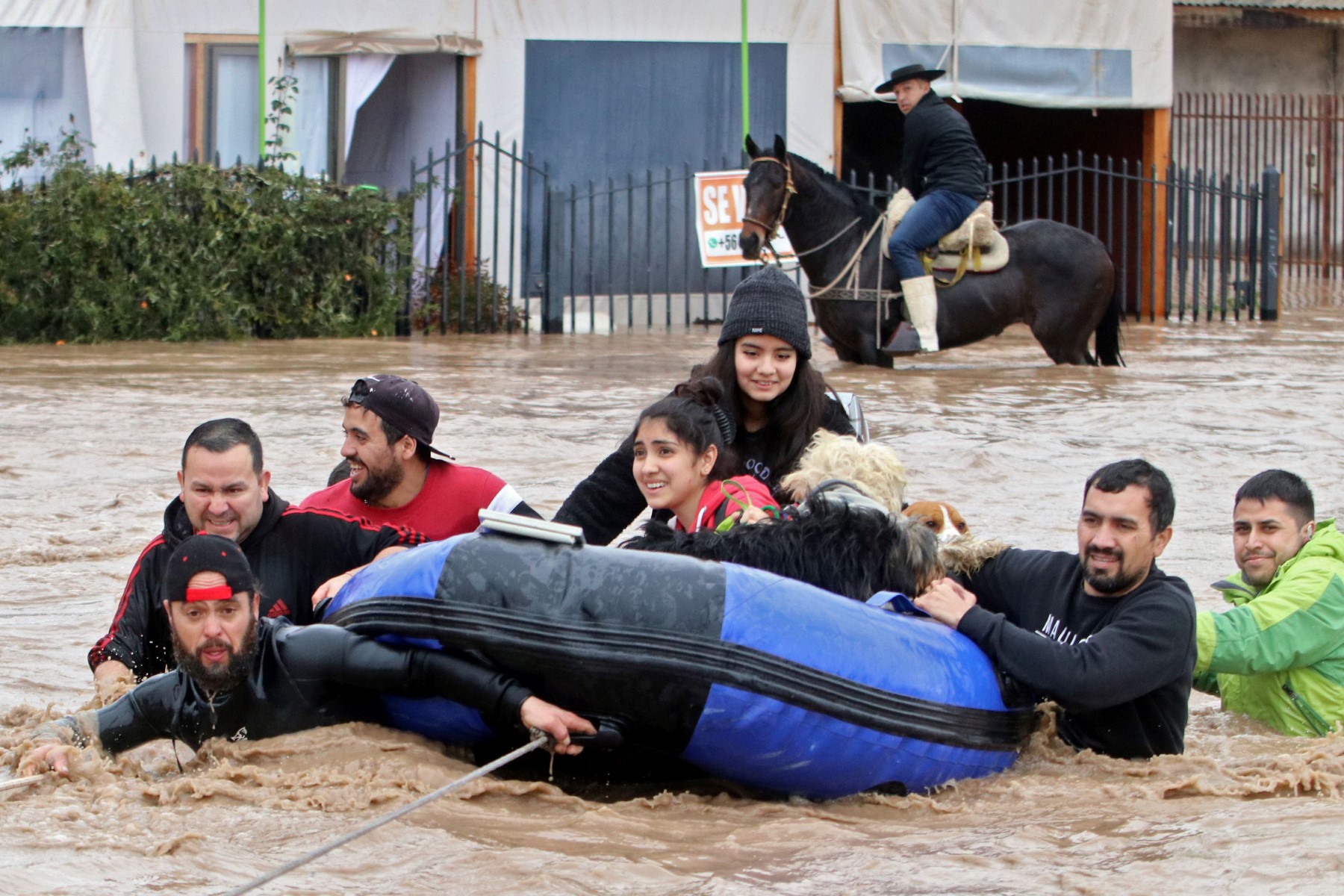Chile is still suffering the consequences of the extraordinary rainfall, the largest since 1993 in some regions of the country, which has left many people dead and missing. Flood waters swept through cities and forced thousands of people from their homes, blocking roads and causing landslides.
Rescue of people and dogs on an inflatable boat in Coltaco, Rancagua, south of Santiago, after heavy rains in the area caused the Cachapoal River to flood. Rains in central Chile left two people dead and six missing. | JORGE LOYOLA / ATON CHILE / AFP / METSUL METEOROLOGIA
Today, when presenting an updated budget for the disaster, the Minister of the Interior, Carolina Tuha, announced the evacuation of 1,800 people from the city of Constitucion, due to the risk of the Mole River flooding. According to the Minister of Foreign Affairs, the decision is due to the high levels of the rivers,
Regarding the damage caused by the storm, the minister indicated that two people have fallen so far, six are missing, 9,814 are isolated, and 2,054 are homeless. Similarly, there are 4,077 casualties, 2,502 homes with minor damage, 895 with major damage, and 54 homes completely destroyed.
On Saturday, the Chilean authorities declared a catastrophic zone in several regions of the country, from Valparaíso to Biobio, due to the problems recorded in central and southern Chile due to the continuous rains caused by the passage of a frontal system and the action of the atmospheric river.
Heavy rains have caused the Mapocho and Maipo rivers, which originate in the Andes mountains and cross the Chilean capital, Santiago, to flood. Other rivers that cross the central region of Chile, such as the Cachapoal, Tinguiririca, and Teno, also overflowed.
The amounts of rain are amazing. Precipitation accumulated in four days was 850 mm at Embalse Bullileo station and 731 mm at Rio Claro in Maule. Noble and Beubio recorded over 500 mm at Rio de Guillen and Impulse Bangui stations. Chilean meteorologist José Vicencio summed up the rain as “crazy”.
The heavy rainfall is due to a very dense atmospheric river that originates in the Pacific Ocean and carries huge amounts of moisture to the Andes Mountains. Since the isotherm is high, that is, the temperature only reaches 0 °C at high altitudes, in many places where precipitation should come in the form of snow, it falls as rain and in excessive volumes.
Atmospheric rivers are long, concentrated regions of the atmosphere that transport moist air from the tropics to higher latitudes. Humid air, combined with high-speed winds, results in heavy rain and snow, depending on the region in the world.
These extreme precipitation events can lead to flash floods, landslides, and catastrophic damage to life and property. Although atmospheric rivers come in many shapes and sizes, the rivers with the largest amounts of water vapor can cause heavy rains and floods, often stopping at flood-prone watersheds.
Such accidents can disable roads, cause landslides and cause catastrophic damage to life and property. A well-known example of an atmospheric river is the “pineapple express,” a powerful atmospheric river capable of bringing moisture from the tropics near Hawaii to the West Coast of the United States.

“Music fanatic. Professional problem solver. Reader. Award-winning tv ninja.”




:strip_icc()/i.s3.glbimg.com/v1/AUTH_cf9d035bf26b4646b105bd958f32089d/internal_photos/bs/2024/V/B/OB9rpAQZ21RtkRUrvXgA/youtube-thumbs-poer.jpg)


More Stories
What does the photo that the United States secretly sent to Ukraine look like?
Buenos Aires will place the detainees in containers
Wild orangutans use the plant to treat a wound environment